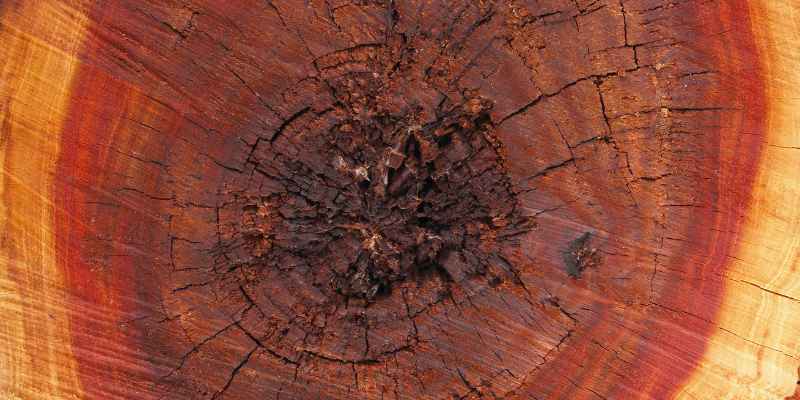Pith in wood refers to the small, soft core at the center of a tree, around which growth takes place. It is the oldest part of the tree and is typically composed of large, thin-walled cells.
The pith area has a greater tendency to crack compared to the rest of the wood. The primary function of the pith is to transport nutrients throughout the plant and store them within its cells. It also plays a role in the healing process of wounded plants.
In older branches and stems, the pith is often replaced by woodier xylem cells.
Exploring Pith In Wood
The pith in wood refers to the soft central core of a tree, where growth takes place. It plays a vital role in transporting and storing nutrients in the plant. Understanding the significance of pith in wood helps woodworkers, carvers, and woodturners make informed choices when working with different types of wood.
Defining Pith In Wood
Pith refers to the small, soft center core of a tree where growth takes place.
Importance Of Pith In Wood
- Transporting nutrients throughout the plant
- Storing nutrients within its cells
- Role in physiological healing processes
Understanding Wood Anatomy
The pith in wood refers to the small soft center core of a tree around which growth takes place. It is the oldest part of the tree and plays a role in transporting nutrients throughout the plant. Carving pieces of wood that include the pith can result in a greater tendency for cracking.
must be in HTML syntax.
Differentiating Heartwood and Pith
Wood is an intricate material composed of various components, including heartwood and pith. Heartwood is the innermost part of the tree, while the pith is the small, soft core around which growth occurs in the center of the tree. These two components play essential roles in the structure and function of trees, and understanding their differences is crucial for woodworking and other related activities.
Functions of Pith in Trees
The pith, located at the center of a tree, has several important functions. It serves as a transport mechanism for nutrients throughout the tree, aiding in the growth and development of the plant. Furthermore, the pith stores these vital nutrients within its cells, contributing to the overall health and stability of the tree. Additionally, the pith has been found to play a role in tylosis, which is a plant’s ability to heal and protect itself from injury or infections.
Pith: At the very center of the tree is the pith, which is the oldest part of the tree. The pith, together with the tree’s first few annual rings, is called juvenile wood. The pith area has a greater tendency to crack than the rest of the wood in a tree.
The primary function of the pith is to transport nutrients throughout the plant and then store the nutrients within its cells. It has also been found to have a role in tylosis, a physiological response that helps in the healing process and defense against pathogens, contributing to the overall health and well-being of the tree.
Effects On Wood Quality
The pith in wood refers to the small soft center core of a tree around which growth takes place. This part of the wood can have various effects on the overall quality of the lumber. Understanding these effects is essential for ensuring the durability and usability of the wood in different applications.
Impact Of Pith On Wood Quality
The pith, being the oldest part of the tree, is typically made up of large, thin-walled cells. Due to its structure, the pith area has a greater tendency to crack than the rest of the wood in a tree. Carving or using wood pieces that include the pith can result in decreased wood quality, as cracks can compromise the strength and stability of the wood.
In addition to its susceptibility to cracking, the pith can also affect the overall appearance of the wood. It is common for the pith to be darker in color compared to the surrounding wood, which can create an undesirable contrast in the finished piece. Furthermore, the pith area may contain pith flecks, which are small specks of darker wood that can affect the aesthetics of the lumber.
Avoiding Pith-related Issues
To ensure high wood quality, it is generally recommended to avoid using wood pieces that include the pith. Instead, selecting lumber that is free from pith or has minimal pith content can help minimize the risk of cracking and enhance the overall appearance of the wood.
When working with wood that contains pith, specific techniques can be employed to mitigate the effects. For instance, sealing the ends of the wood and applying an anchor seal can help minimize cracking by reducing moisture loss. Additionally, turning the wood thin can help reduce stress on the pith area, decreasing the chances of cracks occurring.
Overall, understanding the impact of pith on wood quality is crucial for making informed decisions when selecting and working with wood. By avoiding or properly addressing pith-related issues, woodworkers and craftsmen can ensure the longevity, aesthetics, and usability of their wood creations.
Practical Considerations
When it comes to woodworking projects, understanding the practical considerations of pith in wood is vital. The pith, which refers to the small soft center core of a tree, plays a crucial role in the growth and structure of the wood. However, it can also pose challenges for woodworkers, particularly when it comes to preventing cracks and ensuring the stability of their creations.
Dealing With Pith In Woodworking Projects
Woodworking projects often involve working with different types of wood, each with their unique characteristics. Understanding how to deal with pith in woodworking projects is essential to ensure the durability and longevity of your creations.
Minimizing Cracks Around Pith
One of the main challenges woodworkers face when it comes to pith is minimizing cracks that can occur around it. The pith area has a greater tendency to crack than the rest of the wood in a tree, so it’s crucial to take preventive measures.
To minimize cracks around the pith, consider the following:
- Avoid carving pieces of wood that include the pith, as it is more prone to cracking.
- Choose wood with fewer pith areas for your projects.
- Ensure the wood is properly seasoned to minimize moisture imbalance, which can lead to cracking.
- Apply an appropriate sealer or finish to the wood to protect it from moisture absorption.
By taking these measures, you can significantly reduce the risk of cracks around the pith, ensuring your woodworking projects are solid and durable.
Expert Insights
Expert insights on wood anatomy explain that the pith is the soft core at the tree’s center and plays a vital role in nutrient transport and storage within the plant. Understanding the significance of the pith enhances knowledge of wood structure and properties.
Advice From Woodworking Professionals
Woodworking professionals emphasize the significance of understanding and working with the pith in wood. The pith is the small, soft core at the center of a tree, and it’s crucial to consider its characteristics when working with wood materials. Proper insight from woodworking professionals can aid in enhancing your understanding of how to effectively handle wood with pith.
Techniques For Working With Pith
When working with pith-containing wood, considering various techniques is essential. By employing cutting, drying, and sealing methods, you can minimize the potential for cracks and unwanted distortions that occur around the pith area. Strategies such as sealing the ends and avoiding carving pieces of wood that include the pith can significantly impact the quality of the final product.
Historical Perspectives
At the core of a tree lies the pith, a soft central core crucial for growth and nutrient transportation. It is the oldest part of the tree, surrounded by heartwood, resistant to sap flow.
Evolution Of Pith Utilization In Woodworking
The pith in wood has evolved in woodworking practices over time.
Traditional Uses Of Pith
Historically, the pith was utilized in various traditional woodworking applications.
Innovations In Pith Utilization
The pith, the small core at the center of a tree, is gaining attention in the wood industry for its versatile applications. Innovations in pith utilization are driving new developments in the industry, exploring the potential of this often overlooked component of wood.
Modern Applications Of Pith In Wood Industry
In recent years, modern technologies have unlocked innovative applications of pith in the wood industry. From enhancing wood products to creating sustainable materials, the versatility of pith is revolutionizing the way we perceive traditional wood components.
Research And Development In Pith Utilization
Researchers are actively engaged in exploring the untapped potential of pith in various industries. With advancements in technologies and scientific understanding, ongoing research and development efforts are focused on optimizing the utilization of pith for a wide range of applications.

Frequently Asked Questions On What Is Pith In Wood
What Does Pith Mean In Lumber?
Pith in lumber refers to the soft core at the tree’s center where growth occurs.
What Is The Difference Between Pith And Heartwood?
Pith is the tree’s inner core conducting sap, while heartwood is hardened xylem cells no longer conducting sap.
What Is The Pith Side Of The Wood?
The pith side of wood is the oldest part of the tree located at the center of the trunk. It includes the first few annual rings and is prone to cracking. It is recommended to avoid carving this area due to its tendency to crack.
What Is The Pith Of A Tree Used For?
The pith of a tree is used to transport nutrients and store them within its cells. It also plays a role in the healing process of wounded plants.
Conclusion
Pith is the small soft core at the center of a tree where growth takes place. It is the oldest part of the tree, composed of large, thin-walled cells. While its primary function is to transport and store nutrients, the pith area has a greater tendency to crack.
Therefore, it is recommended to avoid carving pieces of wood that include the pith. Understanding the pith and its characteristics is essential for woodworkers and those interested in wood anatomy.


